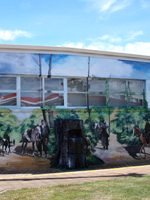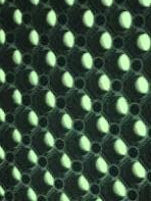Australia So Much to See


Simple ways to use modern communications, deal with mail when on the move and how to choose a simple to use and easy to carry camera.
Mail redirection services. Do you need them? Can you have a family member or trusted friend collect and screen your mail
then email you anything important?
For long term travellers who do not want to be reliant on family or friends, there
are numerous mail redirection service businesses to choose. You need to know where you will be in a couple of weeks to
allow time for the mail to reach the nominated post office when you get there, which means tighter planning, or interrupting your
trip to wait for mail. Some mail redirecting businesses give you the option of them opening your mail, scanning it to send to
you by email, however this will be all your mail most of which is probably unwanted.
Simply the internet: Computers have worked their way into our camping lists these days. After all, you need one to download and back up your digital photos. You may also need it to transfer maps on to your GPS, or even use as a display screen for you navigational mapping. A laptop with a wirelss ADSL modem will keep you in contact with the world when in your network coverage area (or satellite internet if you need daily communication for business or family). Email, instant messaging, Skype or similar are choices you can use. The internet will also keep you up to date with the news if you don’t have television or radio, and you will be able to research travel destinations. If you have mobile internet, using it will be cheaper that using your mobile phone to make phone calls. For times when you do need to use your mobile phone, calls can be expensive, even if you are making a local call. For these, use a public phone if possible.
Never before has communication when travelling been so simple. Where ever there is a signal for internet connection, with the aid of a web cam and a voice over internet facility, travellers can talk to and see family at almost any time.
With the advent of Smart Phones and iPhones and iPads, the internet has never been easier to access, subject to being in a coverage area for your network of course.
Read about the different types of Communication equipment

We choose to have a family member do this when we are travelling, and have never needed to receive surface mail. Where
possible, we have selected email rather than paper mail. All bank statements can be accessed on line, and most documents from
share and security companies can also be accessed on line. Rarely is paper mail important; boxes of it await our arrival at
home and most of it gets binned. If it is a document that needs to be signed, that too can be emailed and as we don’t travel
with a printer, it can be taken by USB drive to a public internet or resource centre for printing. Bills are all paid
on line, with the originals staying a home ready for bookkeeping and filing when we return home. We are running a business.
If
you do need to receive surface mail, rather than pick a city where driving to and parking to access the post office may be difficult,
choose a nice small town where you won’t mind staying a few days if you have to wait. Finding and accessing the post office
in a small town will be easy, and parking nearby will be easier to find.
To me, having a photographic record of the places we visit and things we see for our own memories and so I can share it with others
is a most important part of travel. For this reason I also have a comprehensive system of making multiple copies to ensure no
photos are lost by electronic media failure – see Backing up photos.
We meet some people with professional and semi
professional gear with tripods and lens strapped all around them as they climb up the trail. Too hard for me. I like
a simple and uncomplicated camera that I can take lots of photos quickly while walking, without having to worry about changing lens
or settings. A simple digital camera these days has more settings than most people will ever learn how to use, so special circumstance
shots can still be taken.
Keeping it simple, I like each camera in the family to use the same download cord and if possible the same type of memory card. I like to have a camera that takes AA rechargeable batteries which I use for other appliances so have plenty on hand and one charger suitable for all my AA and AAA batteries. Hint: Keep batteries in match boxes and place those to be charged facing the same way and place them in opposite directions when charged so there can be no mix ups.
I
choose a camera with a good quality lens, one that is small and light enough to carry easily when climbing, and one that has an eye
view as well as a digital screen, as the screen can be difficult to see in bright light. A fast processor is an advantage
when taking travelling snaps. I also take a back up camera; cheaper, but still using standard memory card, cord and batteries. The back up camera is taken in case something goes wrong with the main camera, and is the one taken on something like a small boat
or canoe when a fall into the water is possible.
Do you need a 10 or 12 megapixel camera? Just how big do
you want your prints to be? My first digital camera was 1.3 megapixels, and one of the first photos I took of it of flowers
in my garden at close range still looks clear when used as a desktop on a 19” monitor. The main advantage of taking photos
in higher resolution is when you want to crop something in the distance and see it clearly. I find this more effective than
using the manual zoom lens as I do not hold the camera steady enough to get a good clear picture on zoom, and I don’t want to carry
a tripod up the walk trail.

This picture, of what it think is a tiny wasp nest or a land lobster burrow chimney, was cut out of a photo taken with the 1.3 megapixel
BenQ cheap digital camera; not perfect when cropped to this extent, but clear enough to see the distinctive clay pipe which is about two
centimetres tall. The photo has been cropped to 10% of the original.
While some caravans are keyed alike where possible, many are not, and keys are of different types for door, cargo bay, water fillers
and other hatches. Add to that a few security keys for paddocks, spare tyre locks, hitch locks or external tool boxes and you
end up with a heap of keys to confuse and lose. A visit to a locksmith may reduce the number of keys needed, but in reality
you will always have several.
Now what happens if you lose a key or accidentally lock yourself out of your caravan? I use a very simple system. Each key has a colour coded label, and the duplicates have the same colour system. One set is kept in the caravan together with a spare tow vehicle key. The other set is kept in the tow vehicle. We each have a spare caravan door key as well; his on the ignition key and mine (thanks to the advice of the previous owner of our caravan) stays on a chain around my neck. Another caravanner laughed when he saw my key and pointed to his wife’s similar ‘pendant’. At least if my husband wanders off I can get into the caravan – and the tow vehicle using the spare key.
Once when bush
walking, my husband somehow lost the keys from his pocket, and everything was left locked. My neck chain key let us in, and
we used the spare key from the caravan set for the car. Without that we would have been really stuck, as we were bush camping
alone and off a little used road. We ordered a new ignition key and had other keys cut to replace the lost ones as soon as possible
after that incident.
When you are on holidays, you do not want to spend your travel and leisure time on cleaning. A caravan or motorhome is only a small area, and a daily sweep taking only a few minutes is really all you need to do.
Vinyl or carpet flooring? Whilst carpet can appear warm and inviting, and at home may be considered easy care, when travelling using a broom is quick, whereas storing and getting out a vacuum cleaner, and having the power available to use it all add a burden.
Carpet squares can be used and shaken outside, but I have an easier solution. Having purchased small bath towels to match our curtains we preferred to use the larger bath sheets, so these become floor mats; one just inside the door when we stop and the other bedside the bed at night. Feet can be wiped on them and any dirt shaken off when sweeping. They can be easily washed and dried on laundry days.

The mat is shaken, or rinsed if muddy, and wrapped in the floor towel inside the door so not rubber marks will be rubbed onto the vinyl floor covering in transit.
Dust ingression points can be:
Gas vents on the door. A thin piece of foam rubber or towelling while travelling will collect most of the dust . Remove and shake when you stop. I can place this between the screen an main door and it stays in place. Self adhesive Velcro tabs (hook side) can assist holding your dust screen.
Roof vent. A square of foam rubber around ten centimetres thick fits neatly into our Four Seasons vent to collect any dust that can get in through the closed vents.
Shower drain. This is as simple as putting the plug in when travelling on dusty roads.
Fridge vent. This should be sealed from the interior, and any dust that comes in will settle on the base and can be vacuumed out when you get home if you vent is removable.
Curtains or blinds? This is a personal choice and I prefer curtains. They only need to be wash after a long and dusty trip, and make a good light block out when closed. Being small, washing by machine is easy and it has not harmed my curtains. Curtains do not need to be secured for travel as with venetian blinds which can rattle and have undo wear when on the road.
Exterior. If you have solar panels, you may occasionally hose the dust off them, but with movement they keep fairly dust free. Just water and a broom gets most of the dust of the exterior, and truck was can be used if you have greasy road grime on the walls. Frequent washing will add to the wearing of any decals you have and is not necessary. Enjoy your holiday and wash it when you get home.